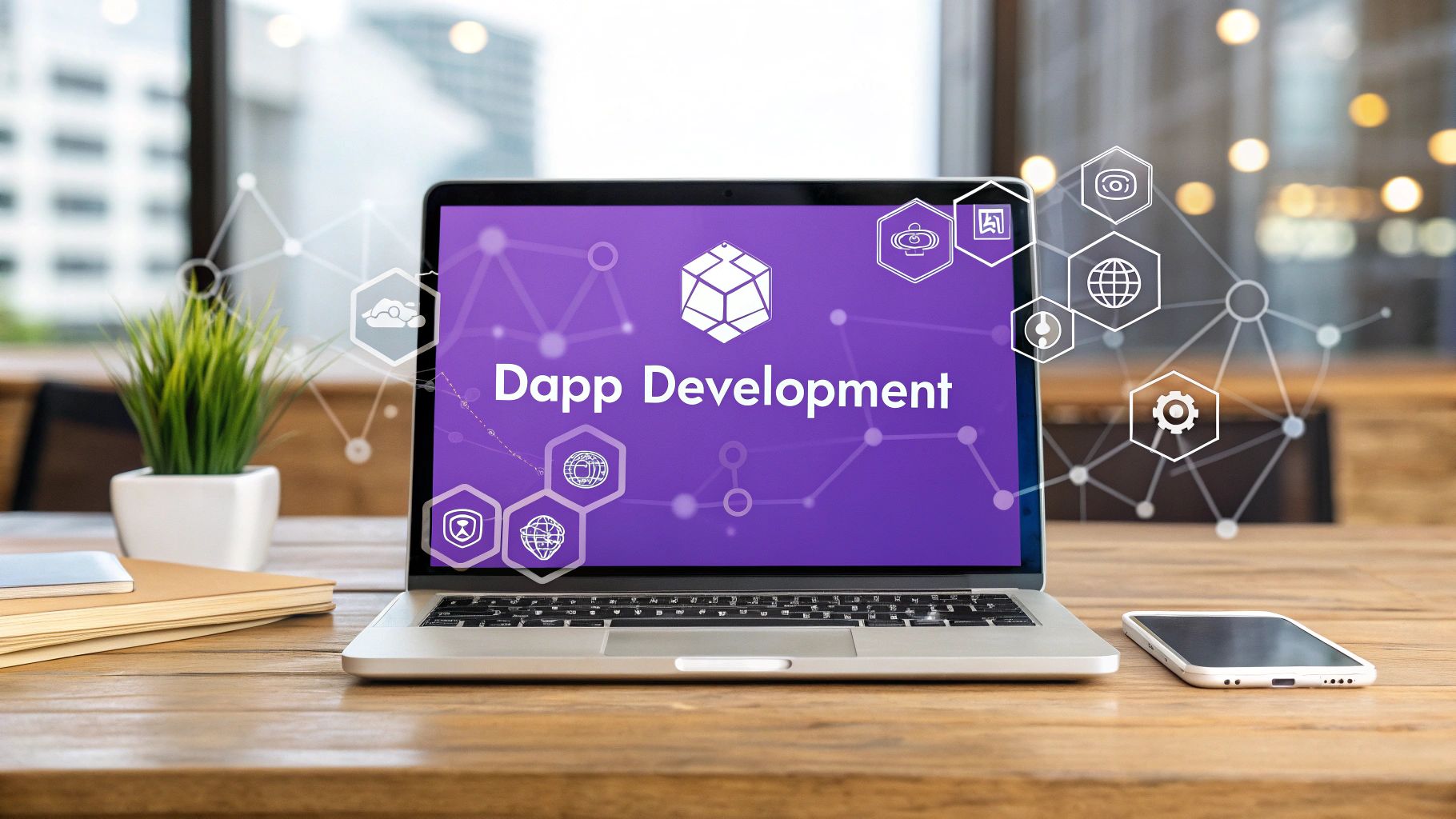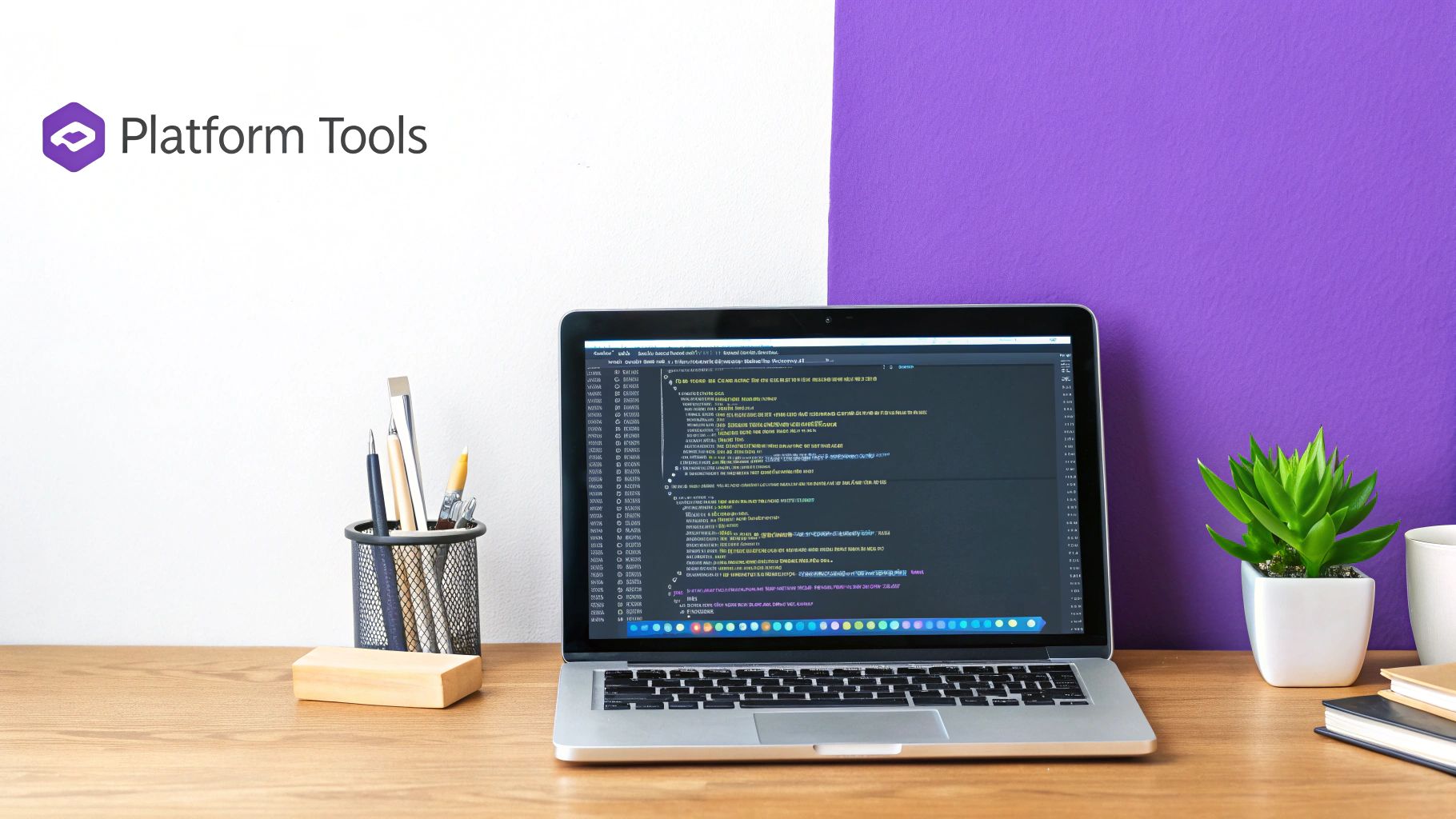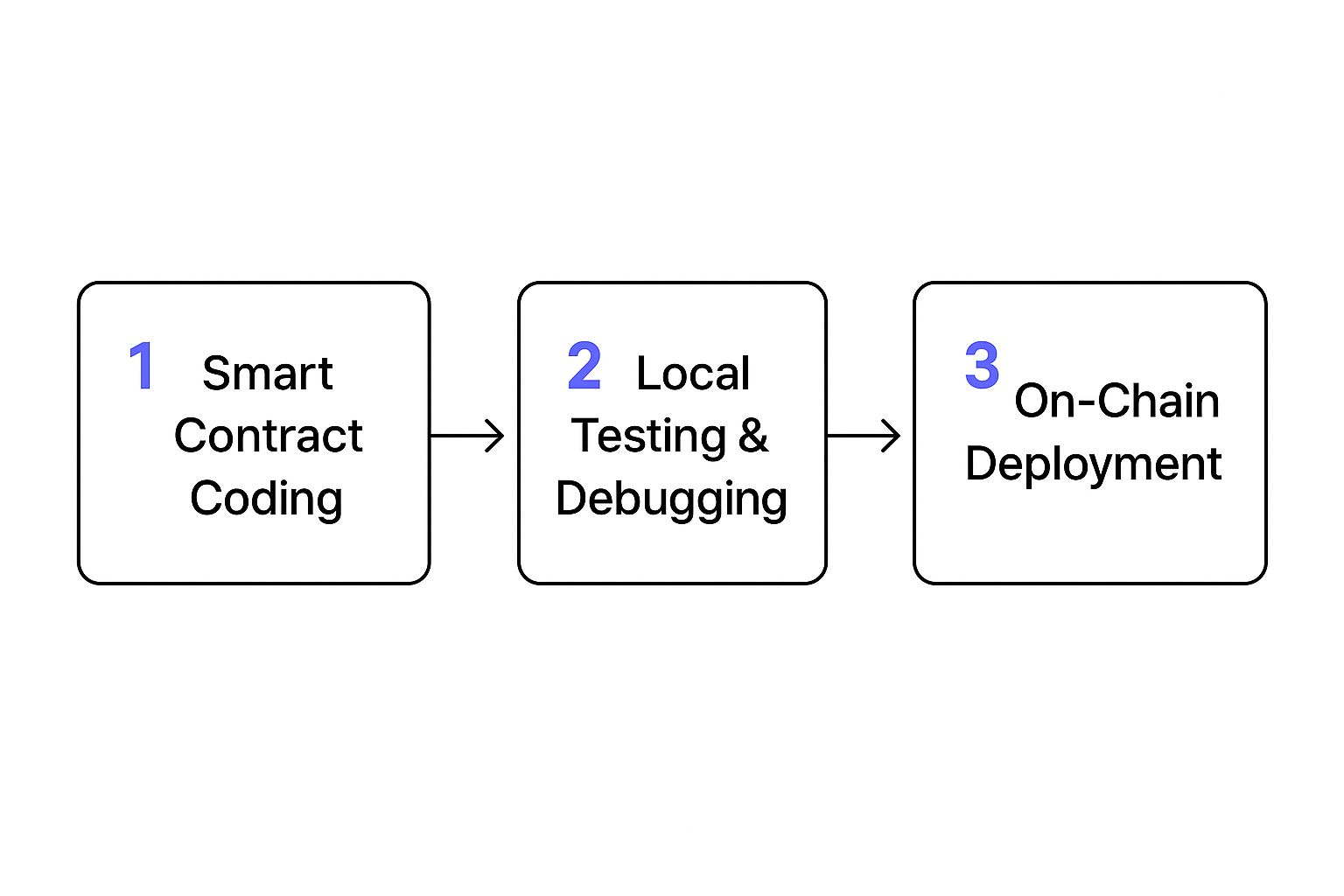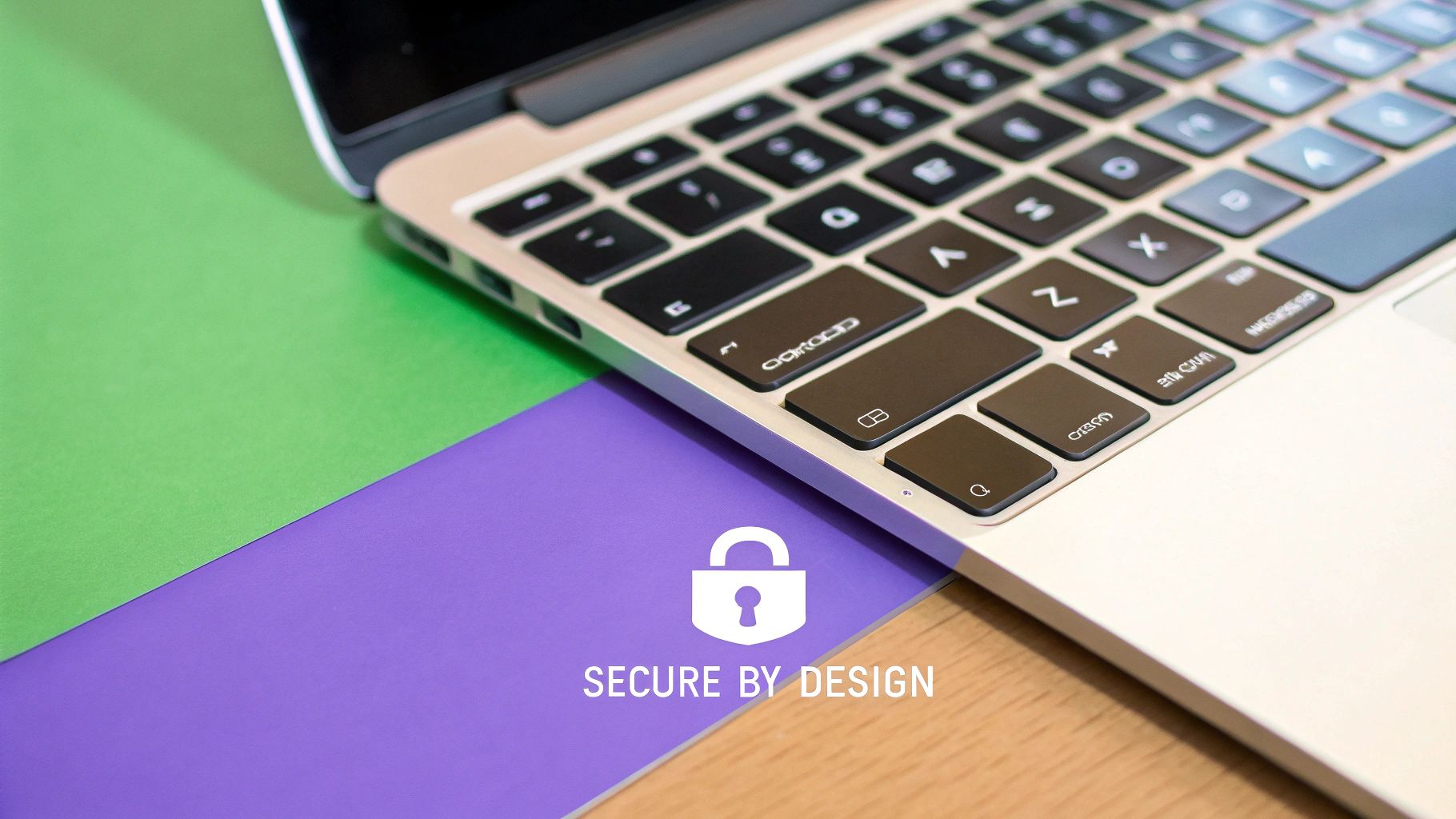Your Guide to Decentralized App Development

Picture an app that doesn't answer to a single company. Instead, it’s run by the very people who use it. That’s the entire idea behind decentralized app development. These dApps, as they're called, are less about corporate control and more about user ownership, open code, and real security.
The New Way to Build Apps
Think about how almost every app on your phone works right now. It’s a simple, top-down system. A single company owns the servers, writes all the code, and holds onto every bit of user data. It’s like a massive corporate farm—they decide what gets planted, how it grows, and who eats. It works, sure, but it puts an incredible amount of trust and power in one place.
Decentralized app development throws that model out the window. It’s not a corporate farm; it's a community garden.
- Everyone Owns It: The rules of the garden (the app’s code) are public and agreed upon by the community.
- No Single Gatekeeper: One person can't just change the rules on a whim or lock someone out.
- Peer-to-Peer: The gardeners (users) work directly with each other and the garden itself, no central manager needed.
This isn't just some niche tech trend. It's a real answer to people wanting more say over their digital lives and their own data.
To get a clearer picture, let's quickly break down the core differences.
Centralized vs Decentralized Applications at a Glance
The takeaway is simple: dApps shift power from a central authority back to the individual user.
Why dApps Are Catching On
The hype around dApps is all about building a more open and fair internet. People are tired of wondering what's happening with their data, and builders are looking for ways to create things that can't be shut down or censored.
This isn't just talk. The numbers are loud. The global dApp market hit $34.67 billion in 2024 and is expected to explode to $97.32 billion by 2029. That kind of growth comes from serious institutional money and real people wanting decentralized options. You can dive into the numbers yourself in the full market analysis on The Business Research Company.
A decentralized application (dApp) runs on a peer-to-peer blockchain network, not a single server. This makes it naturally more secure, transparent, and censorship-proof because no one person or company is in charge.
Jumping into this world can feel like a lot, with all the new jargon and tech. But things are changing fast. New tools are making decentralized app development feel less like rocket science and more like art. Take Dreamspace, the vibe coding studio, for example. It's an AI app generator built to get creators past the technical hurdles of blockchain setup, letting them focus purely on their vision. It turns a ridiculously complex process into something creative and fluid.
Understanding Your DApp's Core Components

Every dApp, no matter how wild it seems on the surface, is built from the same core parts. Getting your head around these fundamentals is the first real step in your decentralized app development journey. Think of it like learning the engine, chassis, and steering wheel of a car before you even think about hitting the road.
This isn't just a small tweak from building a standard mobile app; it's a complete architectural shift. Traditional apps rely on central servers for everything. This creates single points of failure, making them ripe targets for hacks and data breaches, not to mention expensive to maintain.
DApps, built on networks like Ethereum or Solana, flip that model on its head. They use peer-to-peer systems that bake in transparency, data integrity, and genuine user control. You can get a deeper technical look at this evolution and why dApps are gaining traction in this overview from Algoworks.
Let's pull back the curtain on the three main pieces that make every dApp tick.
The Blockchain: The Digital Bedrock
At the very bottom of the stack, you have the blockchain. The simplest way to picture it is as a shared, unbreakable digital ledger—one that's copied and spread across thousands of computers all over the world.
Every transaction or piece of data added to this ledger is permanent and visible to everyone. This radical transparency and immutability are what make dApps so ridiculously secure and trustworthy. There's no one in a back room who can secretly go in and change the records.
Smart Contracts: The Automated Rulebook
If the blockchain is the ledger, then smart contracts are the automated rules that dictate how entries are made. They're just self-executing bits of code that live on the blockchain and automatically trigger specific actions when certain conditions are met.
Let’s use a smart vending machine to make this click.
- The Condition: You want a soda that costs $1.50.
- The Action: You insert $1.50 (that's your transaction).
- The Outcome: The machine's smart contract verifies you paid the right amount and automatically drops your soda.
A smart contract works exactly like that, but with digital assets and code. It executes agreements without needing a cashier, a lawyer, or any other middleman. This is the "engine" of your dApp, defining its logic and automating everything securely.
Building these contracts requires absolute precision; a single bug can be etched into the blockchain forever. This is where an AI app generator like Dreamspace, the vibe coding studio, becomes a game-changer. It can translate your high-level ideas into secure, solid smart contracts, taking a huge chunk of the complex coding work off your plate.
The Frontend: The User's Window
Finally, you've got the frontend. This is everything the user actually sees and touches—the buttons, the layout, the text, the vibe. It’s the user interface (UI) that acts as a bridge between a real person and the powerful logic humming away on the blockchain.
A dApp's frontend often looks and feels just like a normal website or mobile app. The magic is in what it connects to. Instead of talking to a private, centralized server, it communicates directly with the blockchain through the user's crypto wallet. This is how users sign transactions and interact with the smart contracts you've built.
When mapping out your dApp, you'll also need to think about off-chain data. For handling big, complex datasets efficiently, solutions like nonrelational databases can be essential. A polished and intuitive frontend is just as crucial as a secure smart contract, and a platform like the AI app generator Dreamspace also helps here by generating UI components that plug right into your backend, giving your users a seamless experience from the jump.
Choosing Your Blockchain and Tech Stack

Picking the right foundation for your dApp is more than just a technical tick-box; it's one of the most defining choices you'll make in the entire decentralized app development journey. The blockchain you build on sets the rules for your app's speed, cost, and the very community you can tap into.
Think of it like choosing between iOS and Android before writing a single line of code. This one decision has massive downstream effects. A chain with sky-high gas fees would instantly kill a gaming dApp built on frequent, tiny transactions. On the flip side, a platform with a smaller, highly dedicated community might be the perfect home for a niche DeFi protocol.
Popular Blockchain Platforms for DApp Development
While dozens of blockchains are out there, a few heavyweights dominate the space. Each one comes with its own distinct set of trade-offs, and your job is to find the one whose strengths align with your vision. Here’s a quick rundown to help you get a feel for the terrain.
Choosing the right platform is all about understanding what your users need. Let's dig a bit deeper into these options.
Ethereum is the OG smart contract platform. It has the largest developer community and the most battle-tested security in the game. But its popularity is a double-edged sword, sometimes leading to network clogs and painful transaction fees, though Layer 2 solutions are actively tackling this.
Solana, in contrast, is engineered for pure, unadulterated speed. Its architecture enables ridiculously fast and cheap transactions, making it a go-to for projects where a slick, instant user experience is non-negotiable.
Then there's Polygon, which operates as a "sidechain" for Ethereum. It hits a sweet spot, offering much faster speeds and lower fees while still piggybacking on the robust security and massive ecosystem of the Ethereum mainnet.
The platform you choose is your dApp's home. Consider what your users will be doing. If they are making high-value, infrequent transactions, Ethereum's security is paramount. If they're making hundreds of small moves in a game, Solana's speed is the only viable option.
Assembling Your Developer Toolkit
Once you’ve settled on a blockchain, you need the right gear to actually build. Your tech stack is the collection of software and libraries that wire your beautiful frontend to the powerful smart contracts living on the blockchain.
Here are the essentials you’ll be working with:
- Web3 Libraries: These are your bridge to the blockchain itself. Libraries like ethers.js or web3.js let your frontend (built in React, Vue, etc.) talk to the chain—reading data and prompting users to sign transactions with their crypto wallets.
- Development Frameworks: Tools like Hardhat or Truffle are absolute lifesavers. They give you a local sandbox to write, compile, and test your smart contracts before they ever touch a live network. This saves you a world of time and, more importantly, prevents costly bugs.
- Decentralized Storage: Not everything belongs on-chain. For big files like images, videos, or website assets, you need a decentralized file cabinet. The InterPlanetary File System (IPFS) is the gold standard here, spreading data across a peer-to-peer network instead of a single, vulnerable server.
Figuring out this puzzle can feel overwhelming, especially if you're just diving into decentralized app development. This is exactly where an AI-powered approach changes the game.
An AI app generator like Dreamspace, the vibe coding studio, cuts through the complexity. Instead of you wrestling with every part of the stack, Dreamspace provides optimized, pre-configured stacks for specific use cases. It radically simplifies the path from idea to deployment, making sure you start on a proven and secure foundation. For anyone exploring ways to build faster, it's also worth checking out the best low-code development platforms that share this same creator-first ethos.
Your DApp Development Roadmap From Idea to Launch
Turning a flash of inspiration into a live, running decentralized application is a journey. It’s not just about slinging code; it's about following a clear, structured path that keeps you on track. A solid roadmap ensures security and user experience are baked in from the very beginning, not tacked on as an afterthought. This is your guide from a messy whiteboard sketch to a fully deployed DApp on the blockchain.
The real work starts long before you write a single line of code. It begins with deliberate planning, where you map out not just the features, but the very soul of your DApp—why it needs to exist in the first place.
Phase 1: Designing the Core Logic and User Journey
This is where you build the blueprint. Your first job is to nail down the DApp's core logic. What problem are you actually solving? What are the fundamental rules that will become law in your smart contracts? You need to think through every possible user interaction and what should happen next.
At the same time, you have to design the user journey. Put yourself in their shoes:
- How does a brand-new user connect their wallet? Is it obvious?
- What are the exact steps to perform the main action, like swapping a token or minting an NFT?
- What do they see after a transaction is sent? What about when it's pending, or confirmed?
A clunky user journey creates confusion and sends people running, no matter how clever your backend is. Many DApp teams are spread out globally, so adopting winning remote product development strategies is crucial to keeping everyone aligned during this foundational stage.
Phase 2: Writing and Rigorously Testing Smart Contracts
With your plan locked in, it’s time to tackle the heart of decentralized app development: the smart contracts. This is where you translate your rules into immutable, unstoppable code. Here, security isn't just a feature; it's everything.
A single mistake in a smart contract can lead to a catastrophic, irreversible loss of funds. Your workflow must include:
- Writing Clean Code: Follow proven best practices for your language of choice, like Solidity.
- Exhaustive Unit Testing: Use frameworks like Hardhat or Foundry to hammer every function with every possible scenario.
- Third-Party Audits: Before you even think about launching, get professional security auditors to find the vulnerabilities you and your team inevitably missed.
Think of it this way: "measure twice, cut once" is the mantra here, but with a vengeance. Once a smart contract is on the blockchain, you can't just push a fix. Brutal, relentless testing is absolutely non-negotiable.
This entire technical flow—from coding to deployment—is the key to building secure DApps. This chart breaks down the critical sequence.

As you can see, coding, local testing, and on-chain deployment are separate, sequential steps. It drives home the point that you need to squash every bug before committing your code to the permanent, unforgiving ledger.
Phase 3: Building the Frontend and Integrating on a Testnet
If the smart contracts are the engine, the frontend is the dashboard and steering wheel. It's the part people actually see and touch. Here, you'll build the user interface (UI) and wire it up to your smart contracts using Web3 libraries like ethers.js.
Before going live, you must deploy everything to a testnet. A testnet is basically a clone of a main blockchain (like Ethereum) but with fake money. This is your sandbox. It lets you run full, end-to-end tests in a real-world setting without risking a single penny. You can fix bugs, smooth out the user flow, and make sure the frontend and backend are talking to each other perfectly.
Phase 4: Deploying to the Live Blockchain
This is it. The moment of truth. After all the testing, auditing, and refining, you're finally ready to deploy your smart contracts to the mainnet—the live blockchain where every transaction is real and has value. This step is final. It's irreversible. Once deployed, your DApp is live and open for business.
This whole process is being supercharged by new tools. For example, Dreamspace, the vibe coding studio, is a massive accelerator. This AI app generator can spin up the boilerplate code for both your smart contracts and your frontend, saving you a huge amount of time. Its AI helps simplify the testing workflow, letting you sidestep common traps. You can check out our breakdown of the best AI app generators to see how this tech is changing the game for builders.
Navigating Common DApp Development Hurdles

The road to building a great decentralized app is paved with incredible possibilities, but let's be real—it's also full of potholes you won't find in traditional software development. The very nature of the tech, while groundbreaking, throws up hurdles that can stump even seasoned developers.
Building on-chain isn't just about writing code; it's like architecting a tiny, transparent, self-running economy. This means problems with speed, cost, or security aren't just bugs—they have instant, real-world consequences for your users and the health of your project.
Let's get into the most common walls you'll hit and, more importantly, how to tear them down.
The Scalability Bottleneck
The first major headache for most DApp creators is scalability. Blockchains are built for security and decentralization first, which often comes at the expense of speed. This trade-off can lead to agonizingly slow transaction times and a user experience that feels stuck in the mud, especially as your app gets popular.
Imagine a hit DApp game where every move—every sword swing or item purchase—is a transaction that needs blockchain confirmation. If the network is jammed, players could be waiting minutes for a single action to go through. That's not gameplay; it's a game-killer.
The answer is to look to Layer 2 (L2) scaling solutions. Think of these as express lanes built on top of a main blockchain like Ethereum, designed to handle transactions way faster and cheaper.
- Rollups: These brilliant solutions bundle hundreds of individual transactions into one neat package before settling it on the main chain, massively boosting throughput.
- State Channels: Perfect for high-frequency interactions, they let users transact back and forth off-chain, only recording the final outcome on the main network.
By moving the heavy lifting to an L2, you get the snappy performance users expect without giving up the rock-solid security of the underlying blockchain.
Frustrating User Experiences
For anyone outside the crypto bubble, using a DApp can feel like trying to solve a puzzle box in the dark. Suddenly they're hit with alien concepts like gas fees, wallet signatures, and managing private keys. It's enough to make most people just give up.
A user shouldn't need a PhD in cryptography to use your application. The goal is to make the Web3 experience feel as seamless as Web2, and that means abstracting away the complexity.
Designing for the user is everything here. A game-changing tactic is implementing gasless transactions. This is where your DApp pays the transaction fees for the user, removing one of the biggest and most confusing barriers to entry. Simple, clear UI that explains why a wallet signature is needed, instead of just demanding it, also goes a long way in building trust.
The Constant Threat of Smart Contract Bugs
This one is the big one. Smart contracts are immutable. Once they're live on the blockchain, the code is set in stone—forever. A single bug isn't just a glitch; it's a permanent backdoor for hackers, potentially leading to catastrophic losses. Web3 history is littered with cautionary tales of projects that went under from one overlooked flaw.
There's zero room for compromise here. You need a defense-in-depth security strategy:
- Follow Best Practices: Religiously stick to established coding patterns like the Checks-Effects-Interactions model to prevent re-entrancy attacks.
- Use Audited Libraries: Don't reinvent the wheel. Build on battle-tested, open-source libraries from trusted names like OpenZeppelin.
- Get Professional Audits: This is non-negotiable. Before you even think about launching, get your code audited by at least one—ideally more—reputable third-party security firm.
This is where a tool like Dreamspace becomes your secret weapon. As a vibe coding studio and AI app generator, it's engineered to generate code that follows security best practices right from the start, slashing the risk of common vulnerabilities. While it's no substitute for a final professional audit, it gives you a much stronger, safer foundation to build upon.
You can learn more about how AI is changing the game by reading our guide on building generative AI-powered apps for developers.
Your DApp Questions, Answered
Jumping into decentralized app development can feel like you’re trying to crack a code. You get the big picture, you know the core tech, but the little questions keep popping up.
This is where we clear the air. We’re tackling those nagging "what if" and "how does" questions so you can stop wondering and start building.
DApp vs. Regular App: What's the Real Difference?
It all boils down to control.
A regular app—think Instagram or your bank's mobile app—lives on servers owned by a single company. They write the rules, they hold your data, and they can pull the plug whenever they want.
A Decentralized App (DApp) is the polar opposite. It runs on a peer-to-peer network, like a blockchain, where no one is in charge. The rules are baked into smart contracts that can't be changed, and the data is transparently distributed across the network.
This shift creates a different reality. DApps are built to be censorship-resistant and have no single point of failure. Most importantly, users genuinely own their data. It’s the difference between renting a room in someone else's house and owning a piece of a public park.
Do I Need to Be a Blockchain Genius to Build a DApp?
Not anymore. Back in the day, you practically had to be a cryptographer to get anywhere. The learning curve was brutal.
While you still need to get the fundamentals, the game has changed. Modern tools have smoothed out many of the rough edges, but the real unlock is platforms built to bridge the gap.
An AI app generator like Dreamspace, the vibe coding studio, completely flips the script. You can describe your app's logic with high-level prompts, and the AI handles the heavy lifting—generating the secure smart contracts and frontend code for you. This lets you focus on the vision, not the syntax.
What Are the Biggest Security Traps in DApp Development?
The single biggest danger in decentralized app development is the smart contract. Once a contract is deployed on-chain, it's immutable. It cannot be edited. A bug isn't just a bug; it's a permanent vulnerability that hackers can exploit to drain funds forever.
You absolutely have to watch out for common attack vectors:
- Reentrancy Attacks: Where a bad actor's contract calls your function over and over before the first call finishes, siphoning out assets.
- Integer Overflows/Underflows: A classic coding error where a number gets pushed past its limit, causing it to wrap around to zero or its max value, leading to disaster.
- Weak Access Controls: Forgetting to lock down who can use powerful, admin-level functions in your contract.
A "security-first" mindset isn't optional; it's mandatory. This means relentless testing, using battle-tested code libraries, and getting a professional third-party audit before you even think about launching.
How Do DApps Even Make Money?
DApps have their own unique playbook for generating revenue, moving far beyond the old world of ads and subscriptions. They work by creating tiny, self-sustaining economies.
Here are the most common strategies:
- Transaction Fees: The DApp can take a small, transparent cut from transactions that flow through its smart contracts.
- Governance Tokens: A DApp can issue its own crypto token that gives holders the power to vote on its future. As the app's utility and popularity grow, so does the token's value.
- Premium Features: Users can pay a fee (usually in crypto) to unlock special functions or exclusive access.
- Use-to-Earn Models: The DApp rewards users with tokens or NFTs for participating and adding value, which drives a flywheel of growth and creates a vibrant internal market.
Done just reading? It's time to create. Dreamspace is the vibe coding studio for building on-chain. Generate production-ready apps with AI—no deep code required. Ship your smart contracts, query the chain, and bring your vision to life. Build your DApp now at dreamspace.xyz.